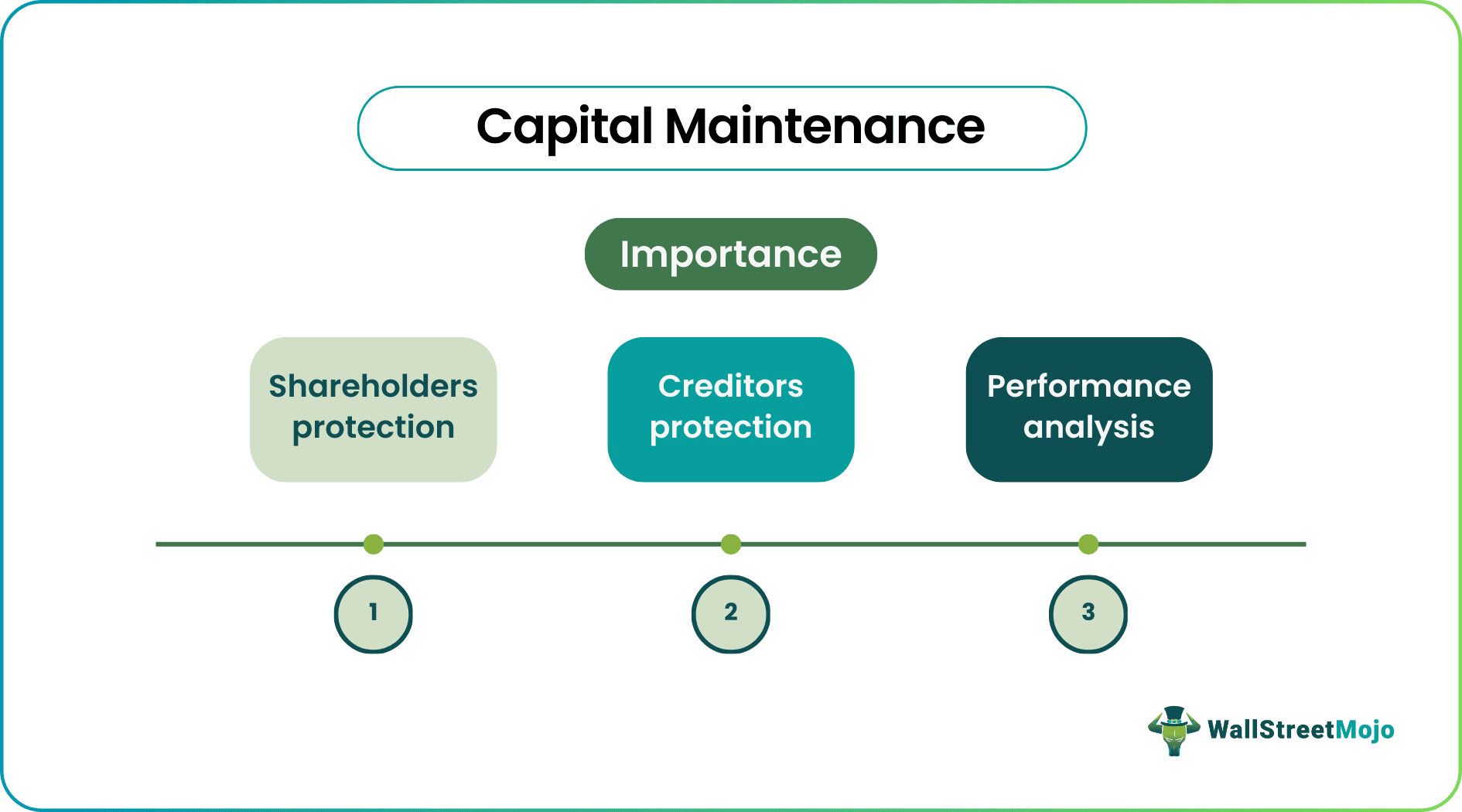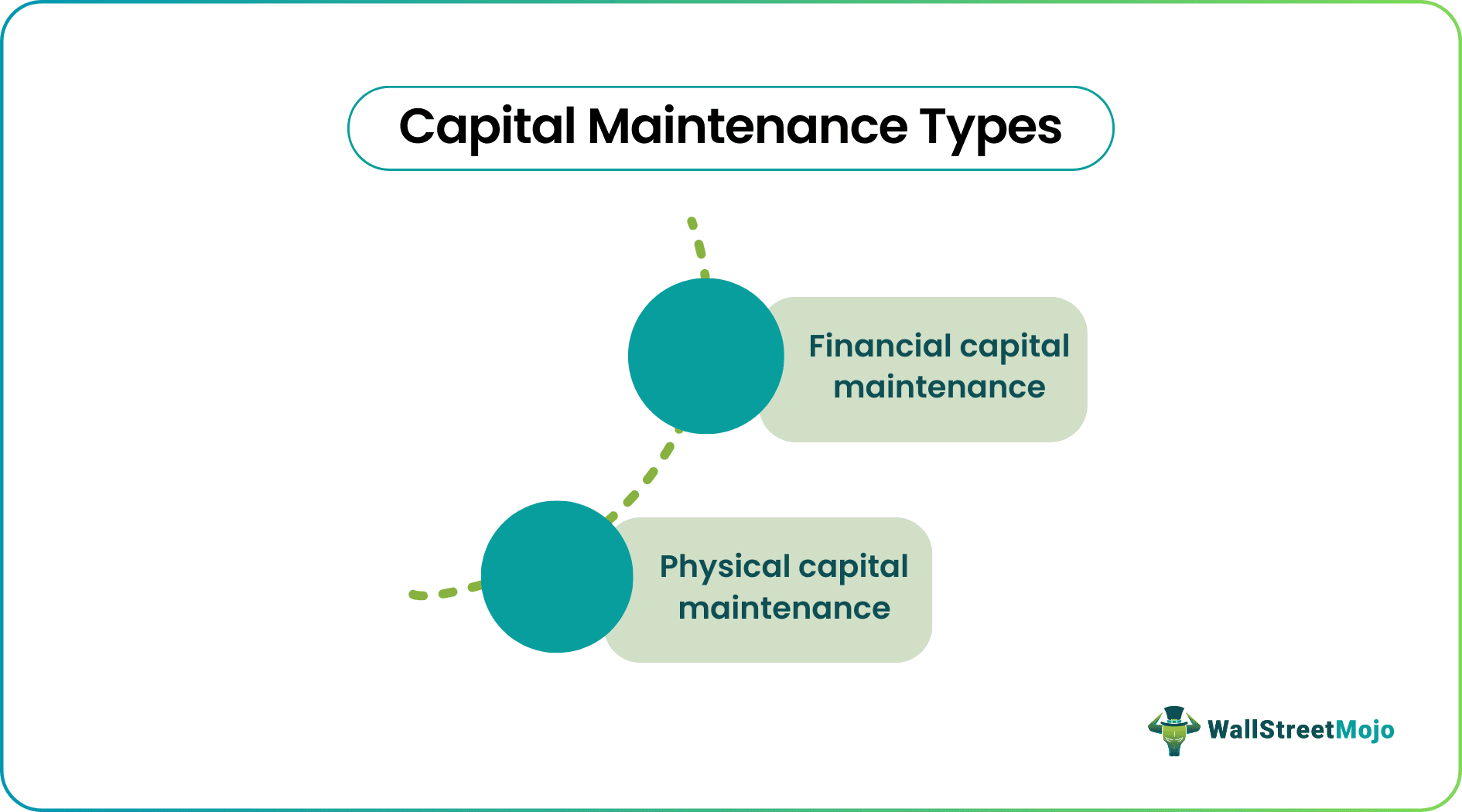Table Of Contents
What Is Capital Maintenance?
The capital maintenance concept states that the business net worth is said to have been maintained if net assets at the end of the period are equal to or more than net assets at the beginning of the accounting period keeping aside any withdrawal during the said period. In other words, it states that the company must book net income only when it has recovered its capital or the cost, i.e., an adequate amount of capital has been maintained.
Key Takeaways
- According to the capital maintenance hypothesis, earnings shouldn't be recorded until enough capital is kept in net assets throughout a financial period.
- When inflation is present, capital upkeep is distorted because the pressure of inflation will cause net assets to expand even if their initial value remains unchanged.
- To assess whether they have achieved capital maintenance, the corporations must change the value of their assets at the time of inflammation.
- Capital maintenance is important because it treasures the shareholders, creditors, and performance analysis of a company.
Explanation
Capital maintenance theory suggests that one must not book profits until a sufficient amount of capital is maintained in net assets during a financial period. In simple words, profit is the expansion of assets during the financial year except for the increase in cash from the sale of stocks to the shareholders and decrease in cash from the dividend payout to its shareholders. This theory is used to track the net assets changes that occurred before revealing the accounting year's profit. It depicts the actual real change in the account balances for the financial year rather than window dressed booked profits.

Capital Maintenance Types

#1 - Financial Capital Maintenance
As per financial capital maintenance, the company will book profit only if the net assets at the end of the financial year are more than the number of net assets at the beginning of the financial year. All the inflows such as the sale of stock to shareholders, the addition of capital from owners, and payment of dividends to shareholders payment of bonus to shareholders are excluded. The two measurement units of financial capital maintenance theory are constant purchasing power units and nominal monetary units.
Financial capital maintenance is affected only by the entire amount of funds available at the starting of the year and the funds available at the end of the year. Therefore, this concept is least concerned with any other capital assets transaction undertaken during the financial year.
#2 - Physical Capital Maintenance
Under this method, the organization's capital is considered as production capacity based on the output units. This method books profit only when the physical production capacity of the business at the end of the year is more than or equal to the physical production capacity of the business at the beginning of the year except any amount adjusted towards any amount paid to owners during the year or any amount raised by the owner. The main use of this method is for checking and maintaining the operational business capacity.
Capital Maintenance and Inflation
Inflation is the increase in any product/service cost or decrease in purchasing capacity. When the inflation rate is high, which has occurred in a short duration of time can affect the business's ability to determine if it has achieved capital maintenance or not accurately. Due to inflation, the purchase price of assets gets increased accordingly, the value of the company's net assets also increases. But the increase due to this inflation misrepresents the original value of the company's assets.
Capital maintenance is distorted at the time of inflation as the pressure of inflation will increase the net assets even if their original value is unchanged. Due to this reason, at the time of inflammation, the companies must adjust the value of their assets to determine whether they have achieved capital maintenance. This is very important if the business operates in a hyperinflationary economy.
Impact
The prime objective of capital maintenance is to safeguard stakeholders' interests like creditors and shareholders. Companies will ensure timely compliance to avoid penal provisions or damage to their brand value with the statutory requirement of maintaining capital requirements. Maintenance of capital ensures the safety of shareholders and creditors invested funds. This will, in turn, affect many potential vendors and investors who are actively looking for investing. Also, analyzing it will help business owners and managers evaluate their performance over time. The company is said to earn profits if its capital remains unchanged or has increased over a while.
Importance
- Shareholders Protection - As per the governing laws of the land, this provision under prevailing acts protects shareholders against losing their capital erosion.
- Creditors Protection - It has an important role in creditors' protection. Due to this rule, a barrier is created that restricts the company from withdrawing money to protect the creditors. This also suggests minimum funds that need to be introduced by the company to fulfill minimum capital requirements.
- Performance Analysis - This helps ensure the protection of shareholders' and creditors' rights. It also enables management and business owners to compare and analyze their business performance over a while or with other companies. This analysis may further suggest suitable action points.

